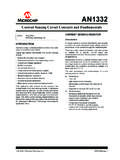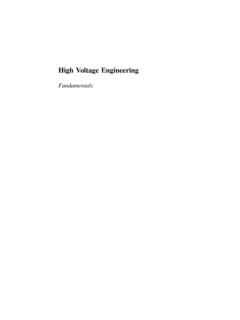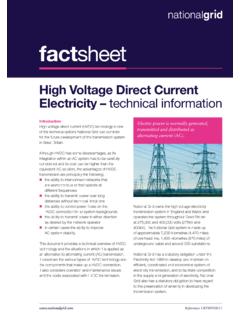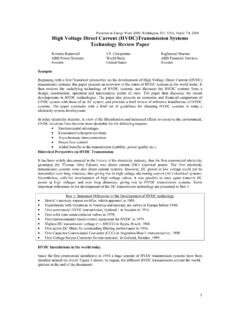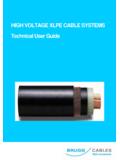Transcription of THE SIMPLE HIGH-VOLTAGE REGULATOR
1 THE SIMPLE HIGH-VOLTAGE REGULATOR Eugene V. Karpov NexTube The English variant is edited by Alex Shekhter In article the availability of a semi-conductor REGULATOR for a feed of the tube amplifiers is consid-ered. The results of comparative testing of two types of HIGH-VOLTAGE power supplies - classical circuit with the output LC- filter and with the semi-conductor REGULATOR were given. The complete description of the schematic circuit of the REGULATOR was given. The adjustment technique of the REGULATOR and feature of his design is in detail considered. NexTube - 2002 2 Introduction The simplest amplifier necessarily comprises the second device - power supply.
2 Directly set of the pub-lications is devoted to amplifiers, and the power supplies are in a shadow, though final result essentially de-pends on their parameters . For solid-state devices with rather low voltage the realization of a high -quality source does not represent the special problems. With HIGH-VOLTAGE power supplies for tube amplifiers the states of affairs are much worse. A certain vacuum here was formed. First, there are no suitable microcircuits directly designed for work with high voltage . Secondly, practically there are no publications of professional development accessible to repeat by the DIYer of average qualification.
3 I shall try partially to fill in this gap and at the same time to solve one more question - question of quality of output capacitors. I would remind readers, that in SE amplifiers, perhaps, most popular with the beginning designers, the signal current of the output stage directly flows through the power supply [1], [2]. Hence, the parameters of a source (output resistance, nonlinearity and dynamics) directly influences upon an output signal. The conclusion is evident, if the source of a plate voltage is ideal, namely, has output resistance near to zero in a wide range of frequencies and endless power, it will not render any influence upon an output signal.
4 Starting from this SIMPLE supposition, HIGH-VOLTAGE REGULATOR was designed. Possible solution The following idea completely naturally looks: the tube circuit - tube REGULATOR . But here there are two "but". First, to be after good output parameters (low output resistance and good dynamics), it is necessary to have high gain in a feedback loop of in a wide band. Such error amplifier is possible to implement on tube, but it will hardly be SIMPLE . Secondly, there is a problem of a regulating tube. Suitable tube for these purposes - is an expensive and scare goods. The way of solving the first problem exists- it is the hybrid circuits.
5 It is quite reasonable approach, but the second problem remains. It is possible to try to use for stabilization high voltage standard integrated regulators (and such at-tempts are undertaken). Though such regulators have excellent parameters, their use is complicated by low in-put voltage (typical value is 40V). For obtaining acceptable reliability, usage of the preliminary REGULATOR with its own current protection circuit is necessary. And nevertheless, it is necessary to use additional circuits for over voltage protection. When all questions of reliability are solved, circuit will not be very SIMPLE . Theoretically, it is possible to use pulse converters, but, to my opinion, the acceptable noise level for such delicate devices can be ensured only with resonant converters.
6 Such devices are not SIMPLE and expensive. For solving of this task I have selected other way: simply to implement the linear HIGH-VOLTAGE REGULATOR , using all capability of modern element base. In result, it became possible to implement the REGULATOR containing only three active elements and having well enough parameters "to be estimated" ideal in the given working area. Testing Before the circuit of the REGULATOR will be shown, I want to present results of comparative testing of a typical power supply with the inductive -filter [3] and power supply with the REGULATOR . The testing circuit on figure 1 is shown.
7 Figure 2 Figure 16 ~Rs= - 2002 3 As the tested circuit , was connected LC- filter, shown on figure 2 or REGULATOR . The values of elements of the filter are chosen close to typical. For stimulation of a variable component of a power supply current was used the stage on the power triode with active loading and working in a class "А" (the circuit of heating and bias on figure 2 are not shown). It is good model of real loading. For measurement of a quiescent current and alternating component of a plate the resistor Rs was used. All tests were conducted in identical conditions (as determined on figure 1). The following parameters were checked up: 1.
8 Output resistance. The measurements were carried out as follows: was established value of a alternat-ing current flows through a power supply in mA (on the first harmonics), the selective voltmeter was connected to points G and A and the variable component of a voltage was measured. The measure-ments were done in a range of frequencies 30Hz - 50kHz (in all 17 points). Under the Ohm law the re-sistance was calculated. The results of measurements on figure 3 are shown . 2. Transient state. For this purpose on an input of the power stage the square pulse moved. The peak-to-peak current was established greatest possible, but without cut-off.
9 Oscillograph was connected to points G and A. Oscillograms are shown in figures 4 7. 3. The output ripple and noise level. For this purpose to output the power supply was connected dummy load, and to points G and A was connected spectrum analyzer. The results of measurements on figures 8 and 9 are shown. 4. Influence of a supply on a spectrum of a stage output signal. For this purpose spectrum analyzer was connected in parallel to the current sensing resistor (to points G and С). The results of measurements are shown in figures 10 and 11. 5. Line regulation and load regulation (only for the REGULATOR ). The results of measurements are given in the table 1.
10 For testing the power supply the following devices were used: Spectrum analyzer - HP 3585A; Selective voltmeter - Siemens D2008; Oscillograph - Tektronix 2425; Oscillator - G3-118; DC voltmeter - V7-46/1; DC current meter - M1107; Figure 3 NexTube - 2002 4 Results analysis Based on results it is possible to make a number of conclusions. The greatest practical interest has a possibility of achievement of low output resistance in a wide band. The output resistance of the REGULATOR is much lower, than that of the LC-filter, and has more stable character.


